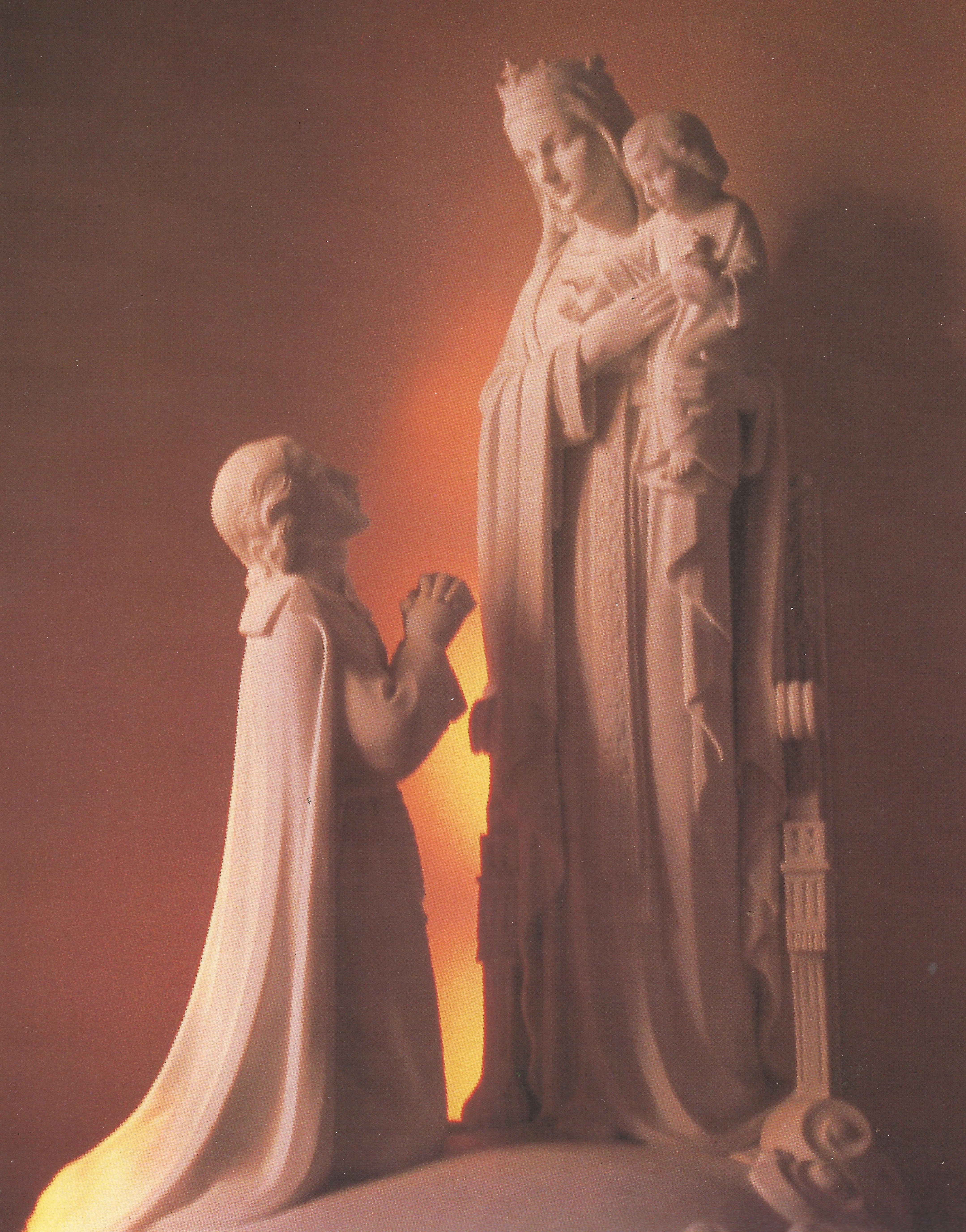Consecration to Christ
Through the Hands of Mary
Fr. Stefano de Flores, SMM
For Fr. de Montfort, one cannot remain a Christian by proxy. One must give oneself over willingly and knowingly to Christ. The gift of oneself to Mary becomes a part of this gift of self to Christ inasmuch as it “conforms, unites and consecrates us most perfectly to Jesus Christ. ” (TD. #120)
Heir to the post-Tridentine spiritual writers of France, St. Louis de Montfort (+1716) represents the high point of devotion to Mary. “It can be said that, with him, the notion of consecration reaches its perfect expression.”
Coming at a critical moment for Marian devotion, such a consecration is centered on Christ, inasmuch as it stresses the sole mediatorship of Christ and establishes a way to arrive at spiritual maturity.
Although Fr. de Montfort makes use of various symbols to explain his form of Consecration (such as: holy slavery of love, contract of alliance, etc.), when he comes to define it, he links it directly to Baptism.
CONSECRATION AND THE BAPTISMAL VOWS
In his book, True Devotion to the Blessed Virgin (which rapidly became a best seller, with more than 400 editions in 30 different languages), Montfort entitled this section: “The Perfect Consecration to Jesus Christ.” He introduced it with these memorable words: “The perfect consecration to Jesus Christ is nothing else but a perfect and total consecration of oneself to the most holy Virgin, which is the devotion which I teach; or, in other words, a perfect renewal of the vows and promises of holy Baptism.” (No.120)
Having drawn upon such spiritual writers as Boudon, Berulle and St. John Eudes, St. Louis de Montfort identifies consecration to Mary with the vows of Baptism in a way, not immediately perceived, that shields our relationship to Mary from the accusation of being oversentimental, and places it at the service of our life in Christ. His purpose is to introduce, in the popular Catholicism of his time (that paid little attention to the baptismal commitment) a devotion to Mary that would go beyond the externals to become an interior attitude and a responsible way of life, based on faithfulness to one’s Baptism.
For Montfort, one cannot remain a Christian by proxy. One must give oneself over willingly and knowingly to Christ. (No.126) The gift of oneself to Mary becomes a part of this gift of self to Christ inasmuch as it “conforms, unites and consecrates us most perfectly to Jesus Christ.” (No.120)
Because of his various writings, foremost among which are: “The Secret of Mary,” “The Love of Eternal Wisdom,” and particularly, his “True Devotion to the Blessed Virgin Mary,” Montfort remains the “classical author” of the Christocentric—Marian devotion. He not only signals out the persons involved, namely, Christ as the ultimate end and Mary as the means and proximate end, but he also presents the consecration as an organic whole with its fundamental principles. (Nos. 60-89); its nature (Nos. 120—134); its motives (Nos. 135—182); its effects (Nos. 213—225); its different modes of expression (Nos. 226—256) and the vital commitments it entails (Nos. 257-273).
In his True Devotion, St. Louis Marie de Montfort describes his own personal relationship with Mary in numerous symbols: for example, that she is the mold, or womb, wherein the Christ—God and the saints are formed (Nos. 164, 218, 260); she is the street (Nos. 50, 158, 218) and the way (Nos. 152-155), that actively lead to the encounter with Christ. The consecration to Jesus through the hands of Mary opens a soul up to the mystical life, inasmuch as it requires docility and total abandonment.
“We should cast ourselves into her like a stone thrown into the sea. .. Remember . . . that Mary is the great, unique mold of God, designed to make living images of God at little expense and in a short time.” (Nos. 259, 260)
By living the consecration to Jesus through Mary and performing all our actions through, with, in and for her (Nos. 257—265), we will mature spiritually: purifying our hearts from selfish tendencies (Nos. 110, 223) and acquire the spirit and virtues of Mary, as well as a profound union with God. By reason of her spiritual maternity, Mary is necessarily concerned with all God’s children (Nos. 30—36); she reveals herself as entirely “relative to God” (No. 225); she introduces us to the liberty of the Children of God (Nos. 161, 169, 215); she is “the easy and sure way of reaching Jesus Christ” and of being transformed into Him (Nos. 62; 152—167; 218—221); and finally, she is an exemplar of how to let ourselves be led by the Holy Spirit (Nos. 20; 34—36: 258—259).
Hidden for over a century “in the darkness and silence of a coffer,” as foretold by St. Louis de Montfort himself (N0. 114), the Treatise on TRUE DEVOTION TO THE BLESSED VIRGIN was discovered in 1842 and published the following year. As a synthesis of a true and perfect form of devotion to Mary that is at once, theological, spiritual and experiential, it is bound to exert a decisive influence on Christian piety and attract many followers to itself.

Father Stefano de Fiores, S.M.M., a doctor in spiritual theology, was a professor of systematic theology and Marian spirituality at Rome’s Gregorian University and a member of the pontifical theological faculty of the Marianum. He is also a former member of the board of directors of the International Pontifical Marian Academy and a former president of the Italian Mariological Interdisciplinary Association (AMI). Author of several books on Mariology and Marian Spirituality, he is the former general editor of the Dictionnaire de Spiritualité Montfortaine, (Ottawa 1994); English Translation: JESUS LIVING IN MARY (Bay Shore, NY 1994).


